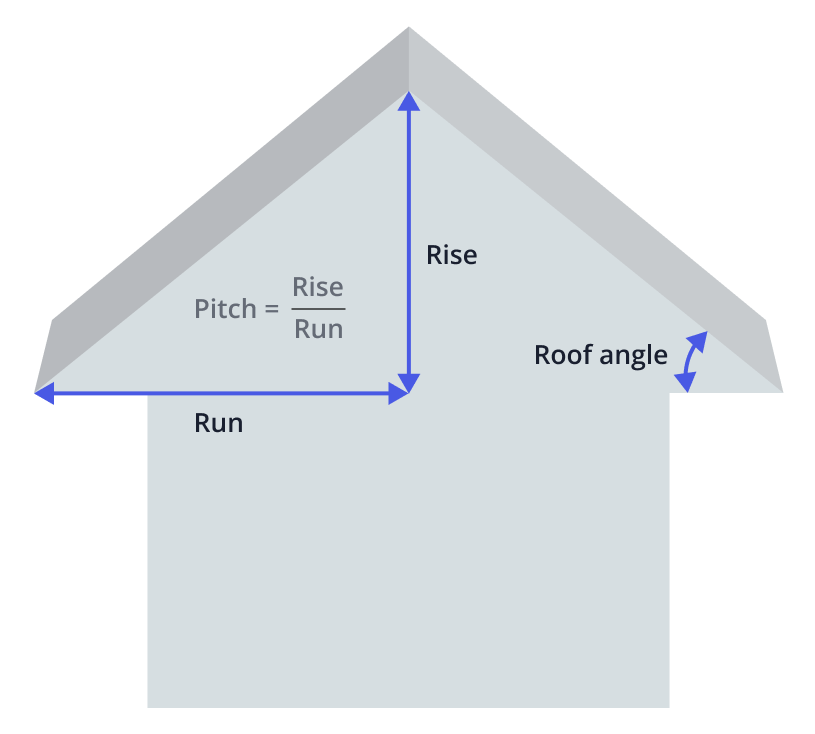Sign up today and start for FREE. No CC required.
For sales: 786 400-2881

Our free roof pitch calculator lets you quickly convert rise, run, angle, and x:12 into roof pitch %, degrees, rafter length, span, and slope multipliers. We also include a detailed calculation example, a multipliers table, and FAQs for home builders, general contractors and roofers.
A Roof pitch describes how steep a roof is. It’s the ratio of vertical rise to horizontal run, most commonly shown as x:12. For example, a 6:12 pitch rises 6 units for every 12 units of run (half the building span). Pitch can also be expressed as a decimal slope (rise/run), a percent grade (slope × 100), or an angle in degrees (atan(rise/run)).

Calculating roof pitch is about finding the relationship between the roof’s rise and its run. You can measure it directly on a roof using a level and tape measure, or determine it mathematically if you know the angle. Roofers and builders often express it as x:12 for practical use, but you can also calculate it as a decimal slope, angle in degrees, or percent grade. The following formulas cover each of these methods.
I have (mode) : Select the known pair you’ll enter: Rise & Run, Angle & Run, Pitch (%) & Run, or Pitch (x:12) & Run. The calculator computes all other values from your pair.
Length unit : The unit for all length inputs and outputs (ft, in, yd, m, cm).
Run : Horizontal distance from the wall plate to the ridge (half the span). Must be > 0.
Rise : Vertical height gained over the run. Can be 0 for a flat roof.
Angle (degrees) : Roof angle above horizontal. Valid range: 0° ≤ angle < 90°.
Pitch (%) : Percent grade, equal to slope × 100. Example: 6:12 ≈ 50%.
Pitch (x:12) : Rise per 12 units of run. Example: 6:12 means 6 units of rise per 12 units of run.
Run : Echoed in your chosen unit (also shown as ft-in or fractional inches when relevant).
Rise : Computed vertical rise that matches your inputs.
Span (2 × run) : Total width of the building across the rafters (eave to eave), assuming symmetrical slopes.
Rafter length (hypotenuse) : Length of a common rafter from plate to ridge (no overhang). Use overhang inputs if you need full rafter cuts.
Slope (decimal) : Rise ÷ run as a decimal. Example: 6:12 → 0.5.
Rise:Run (simplified) : Approximate fractional ratio (rounded to the nearest 1/16 on a 12-run basis). Flat roofs display 0:12.
Roof pitch (%) : Percent grade of the roof surface.
Roof pitch (x:12) : Rise per 12 units of run (the North American carpenter standard).
Rise per meter of run : Millimeters of rise for every meter of run (mm/m).
Rise per foot of run : Inches of rise for every foot of run (in/ft). Numerically the same as x:12.
Rafter length factor (per unit run) : Multiplier to get rafter length from horizontal run: rafter = factor × run (factor = √(1 + slope²)).
Roof angle (plumb cut) : The angle for the plumb cut at the top of the rafter.
Seat / level cut angle : Complementary angle for the birdsmouth (90° − roof angle).
Angle (radians) : Roof angle in radians (engineering notation).
Given : Run = 12 m and Rise = 2 m
0.16679.462°2:1216.667%12.166 m24 m1.01379There isn’t a single “standard.” In many residential markets, common slopes range from 4:12 to 9:12. Local climate, architectural style, roofing material, and code requirements drive the choice.
Costs vary widely based on structure changes, materials, labor rates, and code upgrades. If you’re converting a flat roof to a pitched roof or changing the pitch, request multiple local quotes and include structural engineering in your scope; pricing can swing significantly.
In snow country, steeper roofs shed snow better. Requirements depend on local building codes, design snow load, and roofing material. Many builders target at least 6:12 for heavy-snow regions, while some metal systems allow lower pitches. Always check your local code and manufacturer specs.
4/12 means the roof rises 4 units for every 12 units of run. That’s a slope of 0.3333, an angle ≈ 18.43°, and a multiplier ≈ 1.0541.
“Best” depends on climate, material, and design. Low slopes work for modern aesthetics and some membranes; mid slopes (e.g., 6:12) balance looks and performance; steeper slopes excel at shedding rain/snow and fit traditional styles.
Flat roofs have 0:12 pitch but still need minimum drainage slope per code (often 1/4″ per foot ≈ 2%). For shingle roofs, manufacturers specify a minimum (commonly 2:12–4:12 with underlayment rules). Always follow the product’s installation manual and local code.
30° corresponds to slope = tan(30°) ≈ 0.577. In x:12 notation that’s about 6.9:12, often rounded to 7:12.
The roof pitch multiplier (a.k.a. rafter factor) converts horizontal run to sloped length: rafter length = multiplier × run. It equals √(1 + slope²) or sec(angle).
Multiply horizontal run by the factor to get sloped length. Multiplier = √(1 + (x/12)²) = sec(angle).
Try one of our free Excel templates.
Send $100K+ quotes in 30 minutes or less!
No credit card required